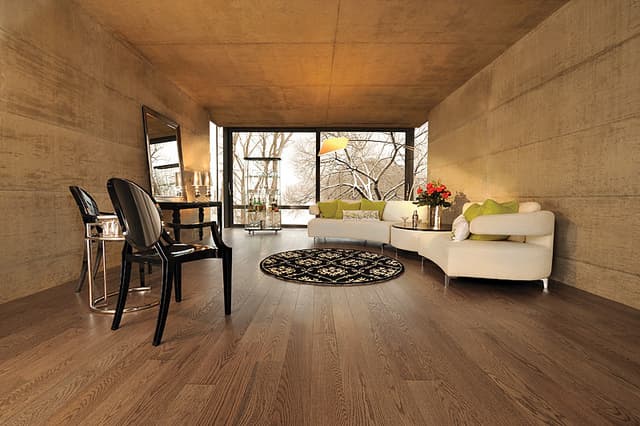Flooring Renovations - Quick and Easy Ways to Cut Costs
By Léa Plourde-Archer
Updated on July 25, 2025

Looking to restore your old flooring without draining your savings? You’re in luck! Undertaking such a home improvement project doesn’t necessarily call for a hefty budget.
What are the most affordable new flooring materials? Are there budget-friendly alternatives for restoring an old floor without carrying out a complete overhaul? How can you optimize costs without compromising on quality and aesthetics?
Discover affordable ways to revamp your flooring while sticking to a budget.
7 Tips and Tricks for Cutting Flooring Renovation Costs

Source : Élévation Studio Design
1- Restore the old flooring
One of the best ways to save money during a floor restoration project is to give your current flooring a makeover. Instead of removing the old flooring and laying a new one, restore the surface to its former glory.
Depending on the current state of the flooring and its composition, such a process might solely entail refinishing or sanding the surface, or applying specific products to conceal deep-rooted flaws. Even if doing so might just be a temporary solution whilst waiting for a heftier budget to carry out a major overhaul, it makes for a decent compromise between replacing the flooring and short-term savings.
Most flooring can be restored at least once, even those made with cheap materials. It’s solely a matter of using the right technique and material-specific products.
Here are some articles published on our renovation blog that could come in handy:
2- Stick to affordable flooring options

Source : Agencé Conception
If your floors are damaged beyond repair, buying new flooring is inevitable.
Engineered wood or laminate are both affordable and resilient, and retailed in a slew of designs and colours. Some also mimic to perfection high-end wood species like mahogany.
Also, upcycled materials are worth considering. Not only are they more affordable, but some are of excellent quality and are just as good as brand-new materials. However, saving a few bucks shouldn’t come at the expense of quality: prioritize value for money.
The most budget-friendly and sought-after flooring options are:
Cork
Linoleum
Vinyl
Concrete
Carpeting or carpet tiles
Rubber
Bamboo
Ceramic tiles
For more information about the listed materials, check out our affordable flooring article.
3- Compare prices and shop strategically
Before rushing out and buying new flooring, take some time to explore your options. Flooring prices may vary from one store to another, and some retailers have regular sales, allowing you to significantly cut project costs.
How can you streamline your research?
Check flooring store flyers and websites to spot sales and promotions.
Compare prices between big box stores, specialized retailers, and online retailers.
If you take the time to compare offers and plan your purchases at the right time (end-of-year sales, Black Friday, etc.), you can save a couple hundred dollars on your project.
4- Opt for discounted or secondhand materials

Source : Plancher CJM Inc.
Home improvement stores and construction material warehouses often have excess inventory or slightly damaged materials, sold at discounted prices. Often, colour variations and slight aesthetic flaws enable buyers to purchase quality materials at discounted prices.
Alternative option: Reclaimed wood or secondhand tiles found on Marketplace or Kijiji. It’ll be much more affordable, but can also be quite appealing in your home while making for an eco-conscious option.
5- Choose easy-to-install flooring

Source : G&H Cabinetry and Woodworks
A great way to save on new flooring is to opt for a model that’s easy to install. Note that the more complex the installation, the higher the costs. All the more so if you hire professional flooring installers.
Steer your decision-making toward flooring that doesn’t call for additional installation costs, such as glueless-click engineered wood flooring (floating floor).
Should you choose the tiling option, opt for a straightforward pattern rather than an intricate, mosaic-like installation. Even at the risk of being less appealing or less sophisticated to some, it’s a great way to save a few bucks.
6- Cut delivery fees out of the equation
Material transportation and delivery fees can quickly drive up your final invoice, especially if you’re buying heavy materials, such as hardwood, ceramic tiles, or concrete.
Cost-cutting tricks:
Get the material yourself: If you have a suitable vehicle (truck, trailer), haul your purchases to avoid the sometimes costly delivery fees.
Bundle your orders: Buy everything at once to avoid staggered deliveries. Some retailers offer free delivery on orders above a certain price point.
Compare options: Some hardware stores offer affordable truck leasing services, which can be quite beneficial compared to conventional delivery fees.
Split the costs: If you know someone else who is in the midst of a similar home improvement project, order together to split delivery fees.
7- Consider a DIY flooring installation approach
If you have the required know-how, time, tools, and motivation, carrying out the work yourself can save up to 50%. You can remove the old flooring and lay the new one yourself if the selected material allows for a DIY approach.
For those who have basic manual labour skills, tiling or laying floating flooring is relatively easy and doesn’t call for professional intervention. However, materials like hardwood or concrete are a bit more complex to install and hiring a professional is likely required in such cases.
Moreover, in the end, beginner errors can be very costly. All the money you might have saved on labour may be spent repairing or replacing your flooring much sooner than anticipated.
Is it worth it? Up to you to decide!
Want to learn more about different flooring options? Check out our Flooring Renovation Guide.
FAQ Flooring Renovations
How to restore damaged flooring?
If your flooring is scratched or surface-worn, a light sanding followed by a coat of varnish or oil should be plenty for revamping purposes. For deeply ingrained damage, such as cracks or split floorboards, you may need to replace the damaged boards or apply wood putty to fill in the holes. If the wood has warped on account of moisture build-up, the typical restoration method consists of drying and sanding the flooring, followed by applying a tailored finish.
How to conceal an old floor?
There are several options if you’re hoping to conceal damaged flooring without replacing it. You can lay loose-fit flooring, such as laminate, vinyl, or parquet over top with underlayment in between. Another option consists of painting the flooring with wood-specific paint for a more decorative approach. If you like the look of untreated wood, a stain or oil finish can give your flooring a modern appeal without concealing its rawness altogether.
How to revamp wooden flooring?
A deep clean using products tailored to wood floors can make all the difference. To revamp a varnished floor, apply a new coat of varnish after lightly sanding the surface. For oiled flooring, apply a coat of protective oil to revamp the surface’s shine and supple quality. If the wood is lacklustre or dry, use a wood-specific renovator to nourish the material and restore its former glory.
How much does it cost to restore flooring?
Renovation costs hinge on the restoration efforts needed. In Quebec, sanding and varnishing costs between $3 and $10 per square foot, whereas replacing the entire flooring can cost over $30/sq. ft., depending on the selected flooring.
For more information, check out our Flooring Financial Guide.
How to sand hardwood flooring?
Floor sanding is divided into several steps, using different sandpaper grits with every layer. Depending on how worn the flooring is and the desired result, you may need to sand the surface four times over.
For more details about floor sanding techniques, check out our article Sanding Hardwood Floors - How to Go About It the DIY Way.
Looking for something else?
Related articles
The latest industry news, interviews, technologies, and resources.

Editorial Team
•12 Aug 2024
Are you finding yourself treading on sagging floorboards and worrying about the next steps, considering that such a problem can domino into a host of other issues and questions?

Amanda Harvey
•07 Nov 2023
Renovating a wood floor can completely change the look of a room and add some much-needed charm. While sanding is often the part of the project where attention is focused, choosing a varnish is actually more important to achieve your desired finish. To understand this project a bit more clearly, here are the different options available on the market.

Christine Simard
•07 Nov 2023
In the kitchen, it’s safe to say that messes and stains are quite common occurrences. If you’re anything like me, things tend to pile up or get misplaced and it’s hard to keep the place looking magazine-worthy 24/7.

Editorial Team
•20 Sep 2024
Whether it be PVC, wood, or aluminum window frames, glazing beads are key pieces of hardware, indispensable for holding the glass in place and effectively sealing windows. Here’s everything you should know about this strip of material.

Léa Plourde-Archer
•07 Nov 2023
Deciding to replace your current floor is a process that should not be taken lightly. Not only is it a major financial investment, but it also takes time. Which material is best? Which colour?